Five UK coastal wonders to see before they go the way of Malta’s Azure Window
In the wake of the collapse of Malta’s spectacular arch, which UK coastal features are under threat from the unrelenting forces of wind and water?

Your support helps us to tell the story
This election is still a dead heat, according to most polls. In a fight with such wafer-thin margins, we need reporters on the ground talking to the people Trump and Harris are courting. Your support allows us to keep sending journalists to the story.
The Independent is trusted by 27 million Americans from across the entire political spectrum every month. Unlike many other quality news outlets, we choose not to lock you out of our reporting and analysis with paywalls. But quality journalism must still be paid for.
Help us keep bring these critical stories to light. Your support makes all the difference.
When heavy storms brought Malta’s world-famous Azure Window, above, crashing into the sea earlier this year, the loss of one of the world’s natural wonders prompted strong emotional reactions. From stunning photographic tributes across social media to the ever-prevalent memes, countries united in memorialising this iconic piece of the Gozo coastline.
While Maltese Prime Minister Joseph Muscat tweeted that it was “heartbreaking”, he rightly confirmed it was unavoidable. While humans tramping across the arch may have sped up its collapse, its demise was, sadly, inevitable as global sea levels rise.
Although it might seem as if the shoreline is permanently fixed, sea levels are known to vary through time and space with each rise or fall having profound consequences for our coastline.
The transient nature of our cliffs and beaches has been evident in the loss of many beautiful features in the last few decades. Arch Rock in Freshwater Bay, on the UK’s Isle of Wight, formed through centuries of coastal erosion, collapsed in 1992, while an enormous section of cliff near Lulworth in Dorset, UK, disappeared without warning in April 2013. This loss of a large section of the South West Coast Path saw tens of thousands of tons of chalk disappear into the sea overnight.
Even more recently, a sandy beach returned to Dooagh on Achill Island off the west coast of Ireland as suddenly as it was removed 33 years previously.
As Britain’s coast evolves in response to sea level changes, there are many spectacular features at risk from sea erosion. The changes in coastal geomorphology are also likely to be more rapid and drastic as sea levels rise and storms intensify due to global warming. Consequently, it is difficult for geologists or geomorphologists to predict when a major change will occur, so it might be wise to visit some of the wonders of our coast now before they disappear for ever. Here are my top five must-see UK sites from the most endangered list.
1. Old Man of Hoy (Devonian sandstone), Orkney
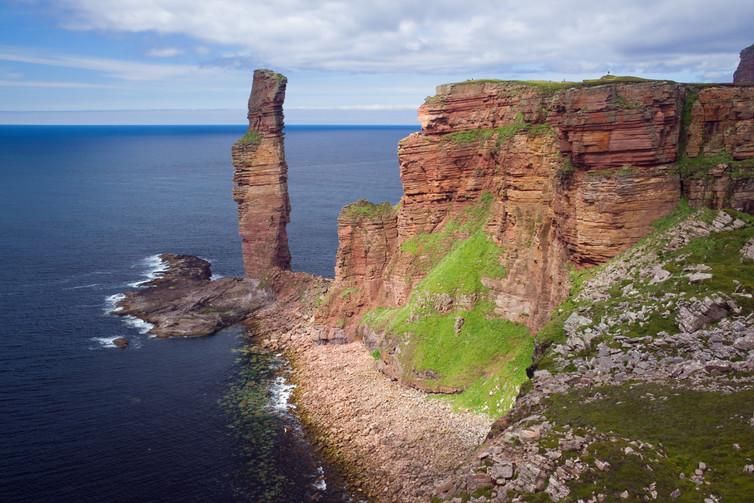
Orkney’s legendary Old Man of Hoy is Britain’s tallest sea stack and stands at an imposing 137 metres above sea level. In geological terms, it is relatively young and maps indicate it was still part of the headland in 1750. Yet this sandstone column that is coveted by climbers and wildlife alike began its evolution more than 400m years ago on the margins of Lake Orcadie, an enormous freshwater lake that covered the area from the south coast of the Moray Firth to Shetland in the north.
Dark basalt lava from the lake’s floor now forms the structure’s base, with horizontal beds of red and yellow sandstone creating the layered overhung profile for which it is famed. So how quickly should we visit this iconic structure?
With a 40-metre vertical crack in the top of the south face and daily battering from the sea on its narrow 30-metre base, The Old Man of Hoy faces constant erosion from gale force winds and high energy waves. More than 100 years ago, the stack looked very different, with an arch at the bottom of a far wider base, giving rise to its name. Evidence of the arch’s collapse is visible in the large rocks scattered on the shoreline.
2. Bow Fiddle Rock (Neoproterozoic quartzite), Portknockie
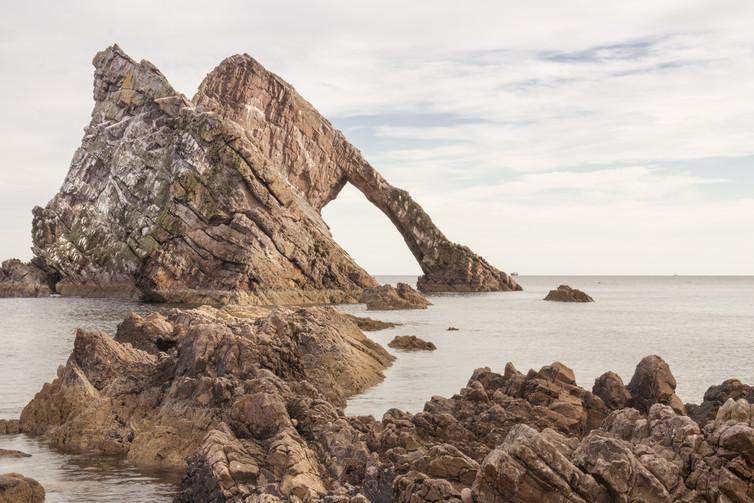
Bow Fiddle Rock is a natural sea arch located near Portknockie on the northeastern (Moray Firth) coast of Scotland and resembles the tip of a bow fiddle. It is composed of resistant quartzitic sandstone – hard, non-foliated metamorphic rock, which was originally pure quartz sandstone – from the Neoproterozoic age (1,000-541 million years ago). It forms the coastal cliff backdrop between Cullen and Buckie and lies exposed to the erosional forces of the North Sea.
3. Durdle Door (Portland and Purbeck limestone), Dorset
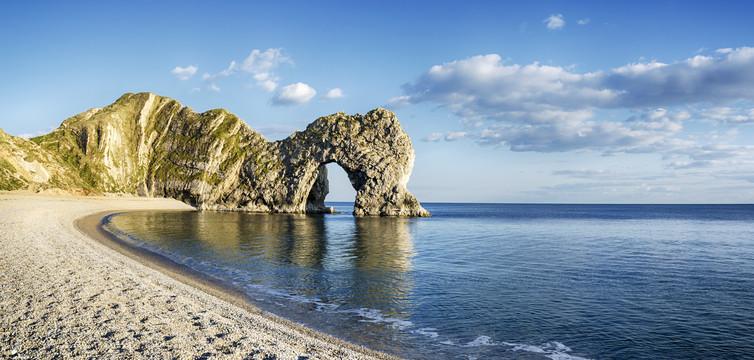
The Jurassic Coast of south Dorset, a Unesco World Heritage Site, beautifully displays the progressive and deleterious effects of sea level rise. Durdle Door is a naturally formed arch resulting from coastal erosion that exploits fractures within the Portland and Purbeck limestones. Just a couple of kilometres east, the spectacular crescent-shaped Lulworth Bay shows what happens when the resistant limestones are removed to expose the softer Cretaceous (Wealden) sediments to the full onslaught of the English Channel.
4. Chesil Beach (Post-Glacial shingle bar), Dorset
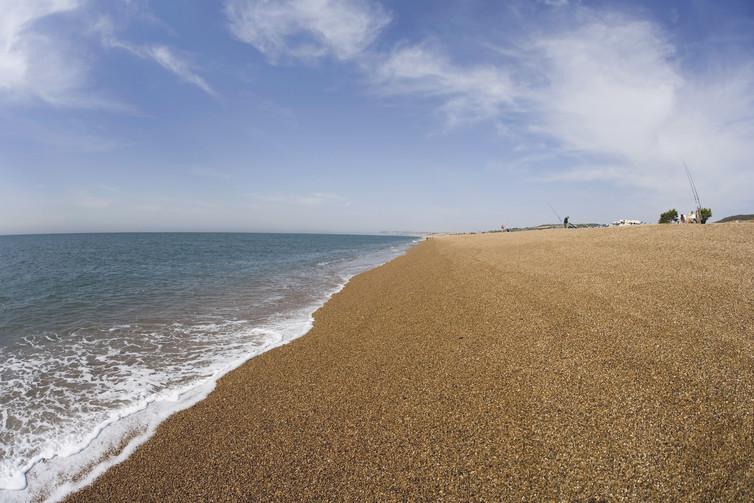
Also part of the Jurassic Coast, Chesil Beach is one of just five major natural stretches of shingle in Britain. This spectacular feature is 29km long, 200m wide and 15m high in places. The shingle, comprising flint, granite, chert, quartzite, porphyry and tourmalised rock, varies from the size of a pea in the northwest to the size of an orange in the southeast. Legend has it that smugglers landing on the beach could tell their location by the size of the shingle underfoot.
Often described as a tombolo (or spit) connecting an island to the mainland, Chesil Beach evolved as a barrier beach, which originated in the English Channel at the time of the last major ice age when sea levels were 125m lower than at present. It then migrated eastwards as sea levels rose in response to glacial melt, before eventually joining the mainland with the Isle of Portland. A further rise could potentially see the beach breached, marine connection reestablished and Portland becoming an island once more.
5. The Green Bridge of Wales (Carboniferous limestone), Pembrokeshire
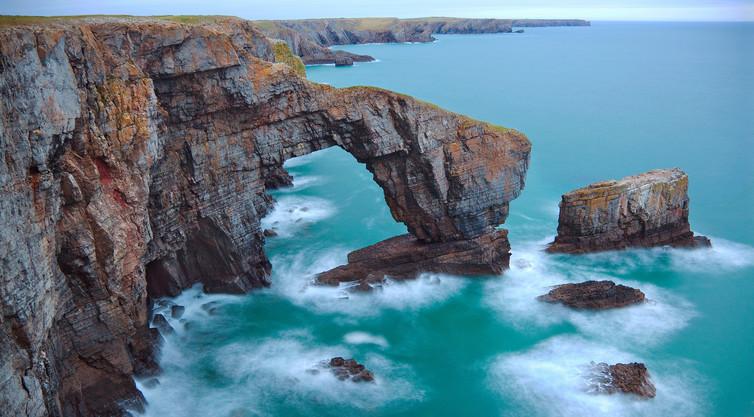
Regularly gracing the pages of tour guides and textbooks, the Green Bridge of Wales is a stunning example of our evolving coastline. Composed of a thick carboniferous limestone, including a proportion of chert – a dark, hard and opaque rock made up of silica – the coastline has been chemically eroded over the centuries as the limestone has been dissolved. Pebbles have been thrown against the rocks, stormy winds have weakened its structure and sand particles have grazed the surface.
The Green Bridge of Wales has been eroded from both sides of the small headland, which resulted in caves forming that eventually met to create the arch that is visible today. The constant stress the arch is under means that, like the Azure Window, it will fall one day. A visit is highly recommended before it becomes a stack.
Rise in sea levels
A third of a metre rise in sea levels could push the shoreline back by 610m in low-lying areas, having an enormous effect on the beaches of the world in general. The increased rate of sea level rise would also counteract the effects of uplift experienced by northern Britain due to post-glacial rebound – the rise of land masses that were once depressed by the enormous weight of ice sheets from the last ice age – even threatening the world-renowned Scottish links golf courses.
As the sea level is expected to rise significantly over the next century, other wonders of Britain’s natural world could be at risk, including the Giant’s Causeway in Northern Ireland and its Scottish counterpart, Fingal’s Cave, in the Inner Hebrides.
Sculpted by erosion, some of these extraordinary formations may be gone in years to come, but they demonstrate that what we love and revere today is very different from a century ago.
While we may mourn the loss of much-loved geological features on our coastlines, the evolution of each natural treasure and the creation of new ones does at least hold the promise of bringing new wonders for future generations to appreciate.
John Richard Underhill is the chair of exploration geoscience and chief scientist at Heriot-Watt University. This article was originally published on The Conversation (www.theconversation.com)
Join our commenting forum
Join thought-provoking conversations, follow other Independent readers and see their replies
Comments